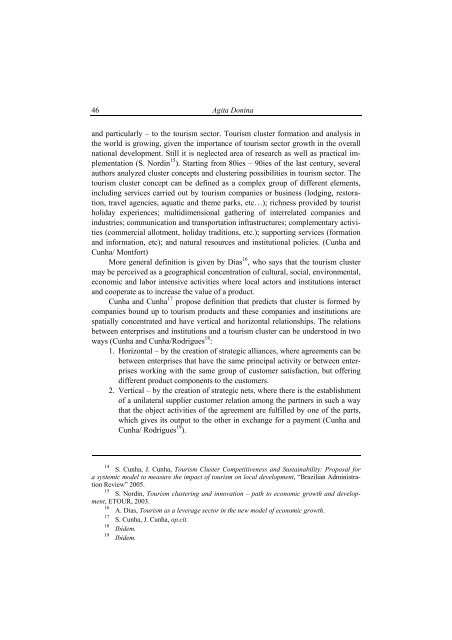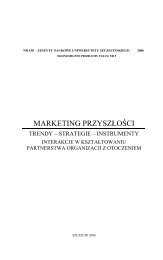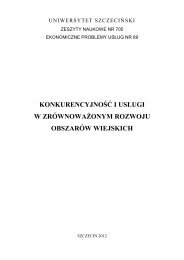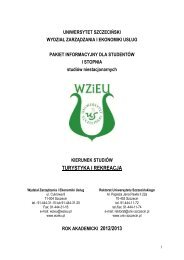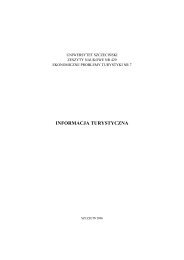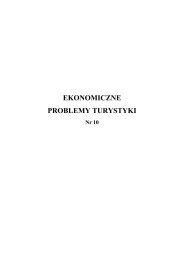Zeszyt naukowy - caÅoÅÄ - WydziaÅ ZarzÄ dzania i Ekonomiki UsÅug
Zeszyt naukowy - caÅoÅÄ - WydziaÅ ZarzÄ dzania i Ekonomiki UsÅug
Zeszyt naukowy - caÅoÅÄ - WydziaÅ ZarzÄ dzania i Ekonomiki UsÅug
You also want an ePaper? Increase the reach of your titles
YUMPU automatically turns print PDFs into web optimized ePapers that Google loves.
46<br />
Agita Donina<br />
and particularly – to the tourism sector. Tourism cluster formation and analysis in<br />
the world is growing, given the importance of tourism sector growth in the overall<br />
national development. Still it is neglected area of research as well as practical implementation<br />
(S. Nordin 15 ). Starting from 80ies – 90ies of the last century, several<br />
authors analyzed cluster concepts and clustering possibilities in tourism sector. The<br />
tourism cluster concept can be defined as a complex group of different elements,<br />
including services carried out by tourism companies or business (lodging, restoration,<br />
travel agencies, aquatic and theme parks, etc…); richness provided by tourist<br />
holiday experiences; multidimensional gathering of interrelated companies and<br />
industries; communication and transportation infrastructures; complementary activities<br />
(commercial allotment, holiday traditions, etc.); supporting services (formation<br />
and information, etc); and natural resources and institutional policies. (Cunha and<br />
Cunha/ Montfort)<br />
More general definition is given by Dias 16 , who says that the tourism cluster<br />
may be perceived as a geographical concentration of cultural, social, environmental,<br />
economic and labor intensive activities where local actors and institutions interact<br />
and cooperate as to increase the value of a product.<br />
Cunha and Cunha 17 propose definition that predicts that cluster is formed by<br />
companies bound up to tourism products and these companies and institutions are<br />
spatially concentrated and have vertical and horizontal relationships. The relations<br />
between enterprises and institutions and a tourism cluster can be understood in two<br />
ways (Cunha and Cunha/Rodrigues 18 :<br />
1. Horizontal – by the creation of strategic alliances, where agreements can be<br />
between enterprises that have the same principal activity or between enterprises<br />
working with the same group of customer satisfaction, but offering<br />
different product components to the customers.<br />
2. Vertical – by the creation of strategic nets, where there is the establishment<br />
of a unilateral supplier customer relation among the partners in such a way<br />
that the object activities of the agreement are fulfilled by one of the parts,<br />
which gives its output to the other in exchange for a payment (Cunha and<br />
Cunha/ Rodrigues 19 ).<br />
14<br />
S. Cunha, J. Cunha, Tourism Cluster Competitiveness and Sustainability: Proposal for<br />
a systemic model to measure the impact of tourism on local development, “Brazilian Administration<br />
Review” 2005.<br />
15<br />
S. Nordin, Tourism clustering and innovation – path to economic growth and development,<br />
ETOUR, 2003.<br />
16<br />
17<br />
18<br />
19<br />
A. Dias, Tourism as a leverage sector in the new model of economic growth.<br />
S. Cunha, J. Cunha, op.cit.<br />
Ibidem.<br />
Ibidem.


